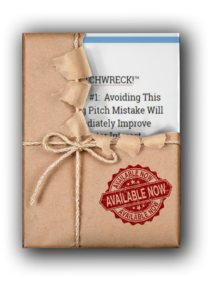This morning I had the chance to review 7 pitch decks from companies that were looking for seed financing. Of the seven decks, most of them failed to get the thumbs up from the angel group I work with. Some part of me wishes that the reason they didn’t get the thumbs up was because their ideas weren’t worthy. But the fact of the matter is that I think that most of the ideas have a lot of potential. As a result, I thought it would be worthwhile to talk today about one of the reasons why those good ideas didn’t make it to the “consider” pile.
Simply put, at the end of the presentation, we weren’t sure exactly what the company did.
With all of the information that is floating around about pitch decks, one of the things that continues to surprise me is how many decks seem to skip the most obvious question: “What does your company do?”
What does your company do again?
Hopefully, when you read that last paragraph your first thought was “you’re kidding”. But the fact is that I see a fair number of presentations from smart people, that leave me scratching my head a bit.
Maybe the problem is that some founders don’t understand the question. The question isn’t “What does your company do?” as in “We make the world a better place”, but more like “What actions does your company do or how does your service interact with people in a way that impacts the world better than the existing products or services?”.
So somewhere in your presentation, either in the deck or in your script, you need to help the audience understand what makes your company unique and effective in solving a problem.
But maybe the problem isn’t that the founder doesn’t understand the question. Maybe the problem is that they didn’t want to reveal their “secret sauce”. There are still founders out there who are worried that if they give away too many details about what they do, that everyone is going to steal their idea. So their strategy is to be somewhat vague. For the record, being vague is not the best path to getting funding.
More than that, if your entire competitive moat is that “no one knows what you are doing”, you’re probably not fundable. Investors look for businesses that are defensible and teams that are in a unique position to execute. If all it takes to compete with you is the knowledge of what you do, then you should consider starting a different company unless there’s room for a large number of competitors in your market.
I’m not suggesting that you include a highly detailed description of your tactics and technical detail in your presentation (yawn). Besides potentially being boring, too much detail eats up precious time in your presentation window. What I am saying is that you need to say enough to make it clear that you are doing something different that has a high likelihood of making some particular thing faster/better/less expensive.
Lastly, the third explanation for why panelists and audiences still don’t know what a company does after the presentation is because some founders just don’t “speak plainly”. I’ve written before about founders that get caught up using jargon, but sometimes founders try to tie together so many big or sexy sounding words, that the audience just doesn’t understand what the company does. The clip below from the show Silicon Valley is supposed to be a parody, but the truth sometimes is closer to this than it should be. The clip is only 20 seconds long, so go ahead and watch it. I’ll wait.
It’s OK to talk to me like I’m a child (in this case)
The bottom line is, if you don’t accomplish anything else during your pitch, you should make sure that the audience understands what it is you are doing or are going to do. The good news is that it’s easy to do that with 2 easy steps.
The first step happens when you are putting together your presentation. Start by thinking about the problem you are solving. Then think about your product or service. Write down how you would explain to an 8th grader what you are creating and why it will help solve the problem. For this first pass, avoid using any language or words that an 8th grader wouldn’t understand. Don’t worry about how long the explanation is, at least not initially. Focus on being clear, straightforward, easy to understand, and simple. Whatever you write down is “what you do”. We’ll call this your “WYD statement” or your “WYD” for short.
If your first version of your “what you do” statement takes you more than 30 seconds to read, then you’ll want to edit it. This isn’t your elevator pitch although this could be a part of your elevator pitch. The difference is that your elevator pitch will include who your product is for and how your product will help. Instead, your WYD is really about what actions your company makes or how you provide a specific solution. It’s just the “what”, not the “who”, “why”, or “how”.
One example might look like this:
“Rather than launching taxis from a central hub, we use big data to determine the best places to locate idle cabs so that we can get taxis to most customers in around 5 minutes. We also use data to provide accurate quotes before the customer commits to the ride and our app gives the customer real-time updates on the status of their taxi.”
Speaking at a normal speed, that example would only take somewhere between 15 and 20 seconds to say. But there is enough in there to differentiate the company from the status quo and provides obvious benefits to the user. There’s no jargon in the example, just plain English. Like a resume, it uses active verbs. What do we do? We use data to locate… We use data to provide quotes… We use data to give updates. If you want to know how the data helps us do all of that, we should set up a meeting.
You don’t need to explain the specifics of the algorithm. You don’t need to explain how GPS works. You don’t need to tell me how you decide which car to send. On the flip side, you don’t want to simply say “we disrupt how you get a ride”.
Test your “What you do” statement to make sure it’s clear
Once you have a decent “what you do” description drafted, you’ll want to take it for a test drive. By that, I mean that before you test the description in front of investors, test it on some other people first. Find a friend or two that are not in your industry and not part of your startup team. If you have friends that would fit as part of your target audience, they would be the best. But being part of your target market isn’t necessary. And I’m not kidding about the 8th graders. If you can test your statement on a real 8th grader, then, by all means, do it.
Start by telling your friends the problem or problems that you are setting out to solve. If they are part of your target market, ask them if they feel the problem is a real pain point. Then read your WYD to those friends and then ask them to explain, in their own words, how your company helps to solve the problem. I say “in their own words” because you don’t want them to just parrot back what you said. You want to see if they understand what you do. If they can give you back a pretty good description of what you do, mission accomplished. Bonus points if they understand how your activities or service actually impact the problem. If, after hearing the problem and what you do, they don’t understand how your company reduces or solves the problem, then go back to Step 1.
The way you frame the problem you claim to be solving is as important as the solution. Make sure that there is an intuitive connection between the two. In the example above, imagine that the presentation had described the problem as being that “Taxicab rides are too expensive”. The WYD statement I used in the example wouldn’t necessarily have any impact on the cost of cab rides. In fact, with more data, a company might be able to charge “surge prices”.
The wonderful thing about an effective WYD statement is that you will use it over and over again in a wide variety of conversations. You’ll use it to fundraise, to recruit, and even to attract customers. So it pays to take a moment to make it as clear and compelling as you can. And for goodness sakes, don’t forget to include somewhere prominent in your presentation.



